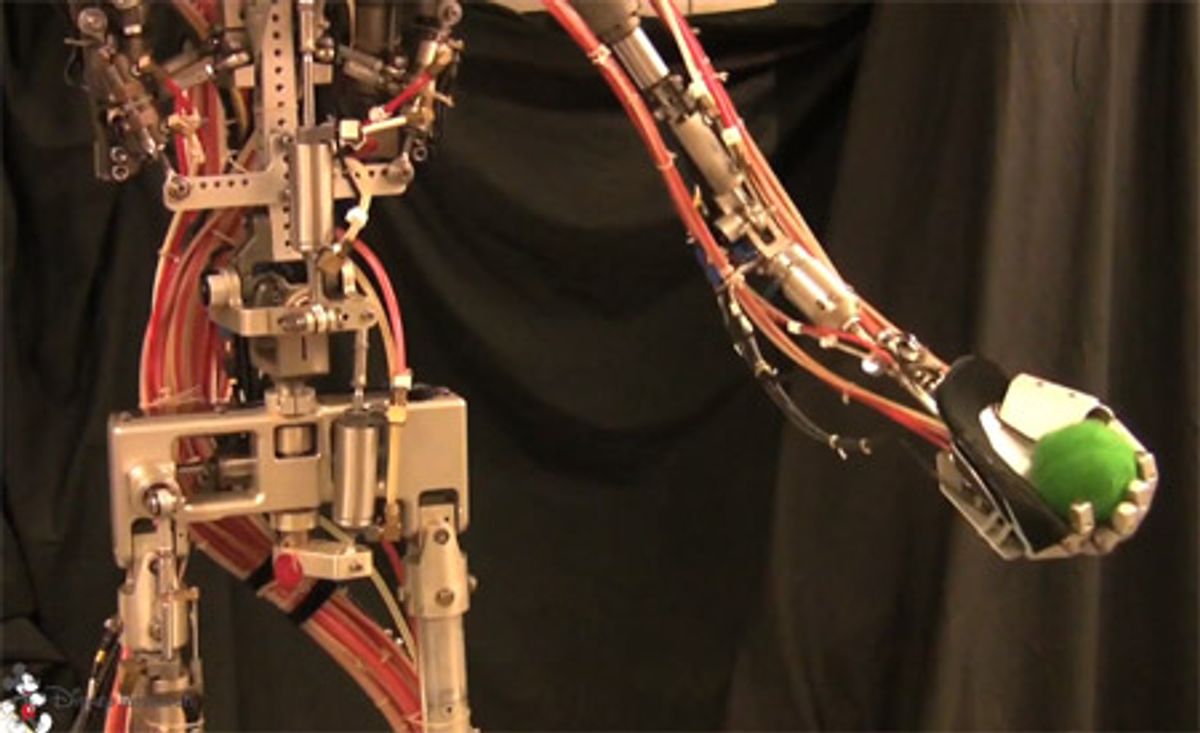As you may (or may not) not have noticed, I've been on vacation for the last couple weeks getting acquainted with manta rays, Komodo dragons, suicidal Balinese on mopeds, and quite possibly malaria, dengue fever, and/or intestinal parasites. I'll keep you updated on those last three. Many, many thanks to Erico Guizzo, Angelica Lim, and Frank Tobe for filling in so capably, and I can only hope that y'all won't be too disappointed to have me back.
To get back into the swing of things, we'll be playing a little bit of catch-up today, with a run-through of some robotics news from the last few weeks that you may have missed.
Disney Robot Plays Catch
Disney Research has what seems to be a fairly robust robotics division that's working on everything from wall climbing robots to artistic swarms. Looks like they have a humanoid in the works too, and they've already taught it to throw and catch. The notable thing here is how interactive the robot is: untrained humans are able to play games with the robot, and as the video shows, the humans readily talk to the robot (especially when it misses), even though any design considerations that favor human-robot interaction seem to be a bit of an afterthought at this stage.
It sounds like Disney is hoping to use technology like this to make theme parks a bit more interactive, which sounds like a good idea to us, although we're not sure how it's going to shake out with the existing interactive humanoid robot that's currently on display at Disneyland. Deathmatch, perhaps?
[ Disney Research ]
Rat Heart Cells Power 3D-Printed Biobot
Muscles make for wonderful motors, which is why we're full of them instead of servos. Researchers at the University of Illinois at Urbana-Champaign have made a tiny little robot out of 3D printed hydrogel that runs on muscle cells that have been, uh, "harvested" from the hearts of newborn rats. The robot is just 10 millimeters long, but it can gallop (?) along at over 200 micrometers per second when the muscle cells flex in unison:
The next step is to give these robots their own vascular systems to provide nutrients to all of the heart cells, and endow them with biochemical sensors that will allow them to steer themselves toward different targets in the body and then deploy drugs once they get there.
Autonomous UAV Designed for GoPros
There are lots of ways to build your own UAV equipped with fancy cameras and an autopilot system, but if you don't want to take the trouble, you could just buy this thing: for less than a thousand euros, Lehmann Aviation will sell you its LA100 foam and carbon fiber flying wing UAV, which has been specifically designed to autonomously ferry a GoPro to five minutes worth of GPS points up to 100 meters AGL. There are two downsides: firstly, the landings are what you might consider to be the "crash" type, and secondly, actually using this thing might not be entirely cool with the FAA.
[ Lehmann Aviation ] via [ Gizmodo ]
Sharp's Cocorobo Robot Vacuum is Packed With Features We Care About
Yes, it's another robot vacuum that'll only be available in Asia, but the reason that we like Sharp's Cocorobo is that it's got a whole bunch of features that a.) we haven't already seen in a Roomba and b.) we actually might care about. The Cocorobo is remotely accessible from outside the home, and the room mapping app is kinda cool, but we're especially interested in the idea of integrating robots into a semi-autonomous intelligent home system. In other words, Sharp is trying to create one piece of software that can talk to your cleaning robots, your lights, your appliances, and everything else in your house all at once. It's possible that iRobot has taken the first step towards something similar with its new wireless tech, but unfortunately we still seem to be lagging far behind Asia when it comes to integrated home autonomy.
Via [ Diginfo ]
Evan Ackerman is a senior editor at IEEE Spectrum. Since 2007, he has written over 6,000 articles on robotics and technology. He has a degree in Martian geology and is excellent at playing bagpipes.





